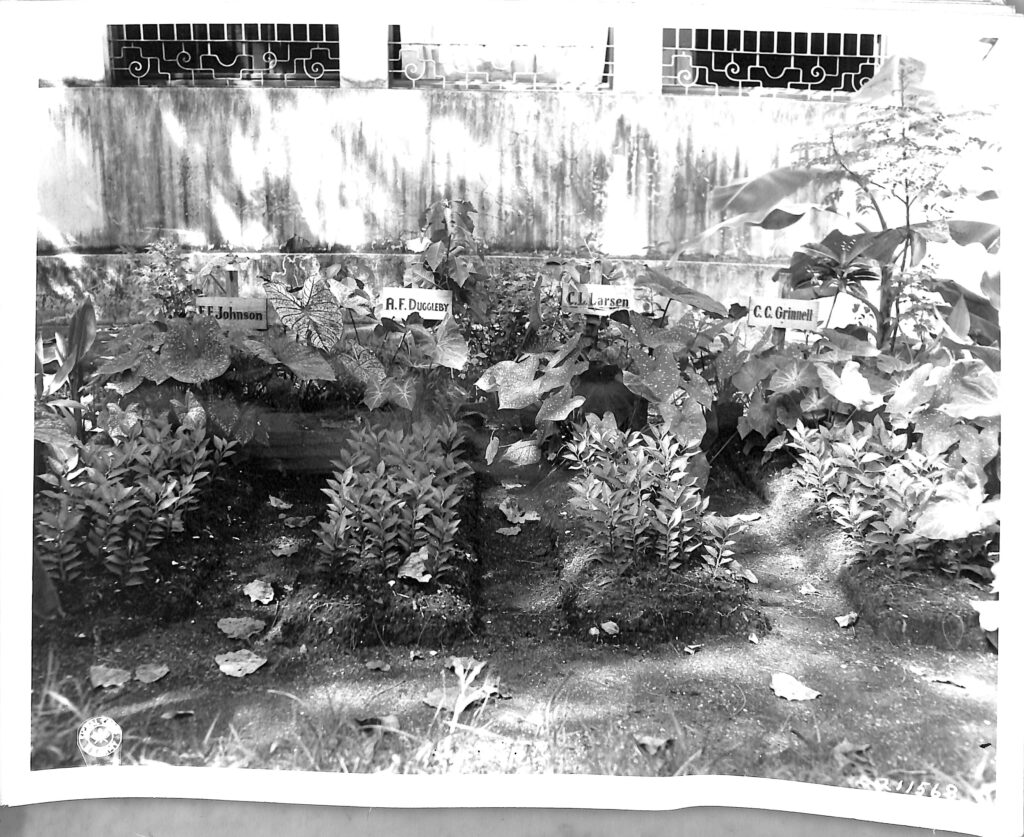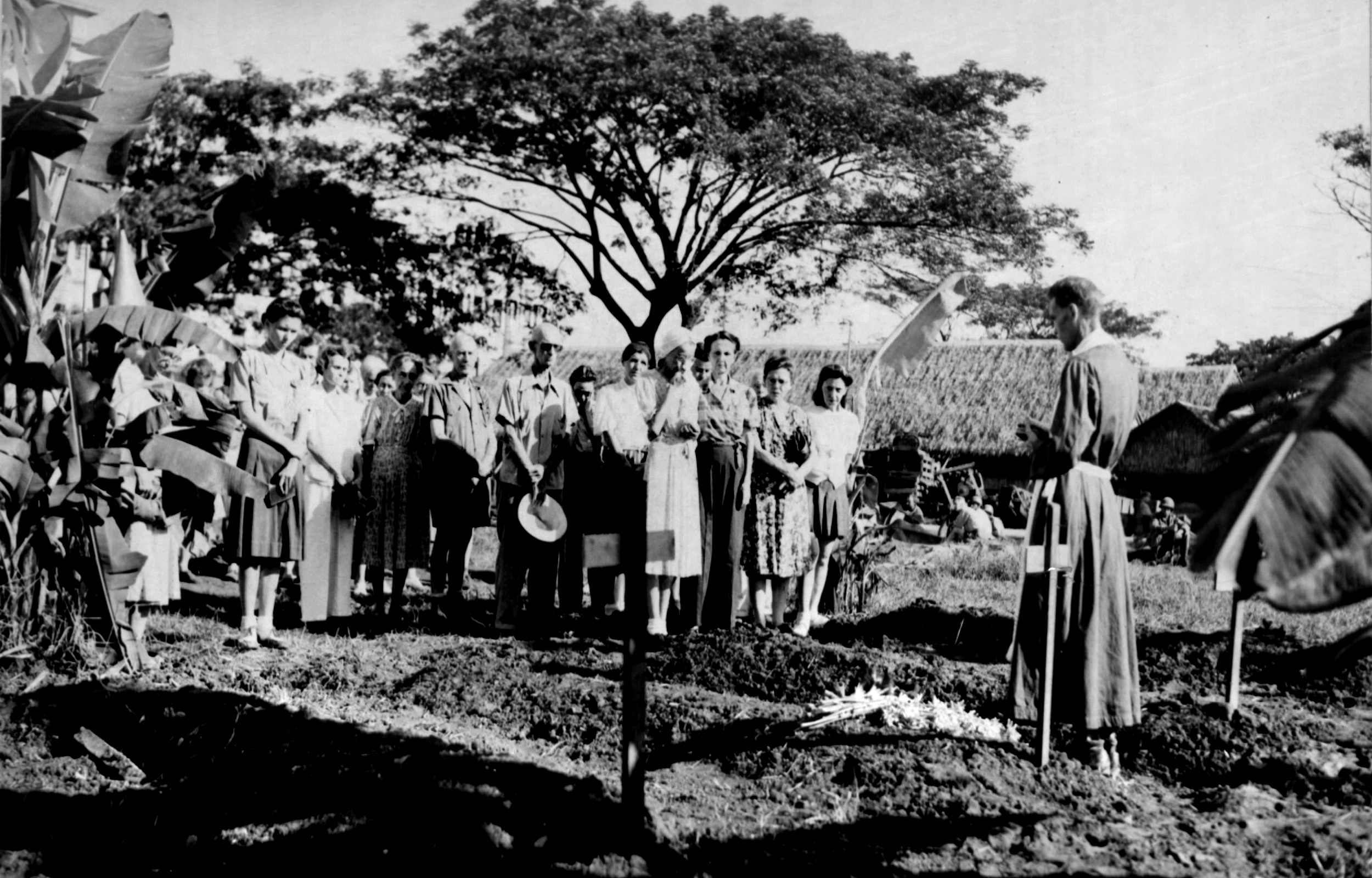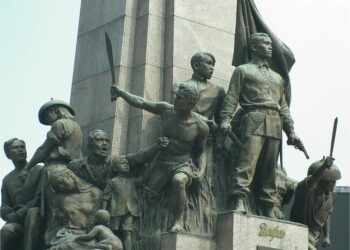He never overlooked an opportunity to give help and assistance to individual internees and by his untiring efforts he obtained huge sums of money for use in buying food, clothing, medicines, and hospital supplies badly needed.
So stated a citation issued to Ruth Grinnell when her husband Carroll was posthumously awarded the Medal of Freedom for his leadership of the internees at Santo Tomas from 1942 to 1945.


Grinnell, along with other camp officers Alfred Francis Duggleby, Clifford Lawrence Larsen, and Ernest Emil Johnson were executed by the Kempeitai on or about Jan. 15, 1945 for yet unknown reasons.
Before WWII came to the Philippine shores, Grinnell was president of the General Electric (PI) Inc. and the commercial manager for the Far East; Duggleby was vice president of Benguet Consolidated Mining Company; Larsen was with the Atlantic Gulf and Pacific Company and Johnson was foreign representative for the U.S. Maritime Commission.
When the Japanese forces occupied Manila, the Japanese converted the campus into an internment camp for foreign civilians, mostly Americans and British, were interned for 37 months.
The camp
The 20-hectare camp within the walls of the University of Santo Tomas was the largest interment camp in the Philippines. It was liberated by the American forces on Feb. 3, 1945, one day before the internees were to be executed by the Japanese.
Although they were kept within the walls of the campus, the internees were self-governing and were left to their own devices within the camp.
At the camp, the internees organized themselves into a village where they have an internee committee that served as their liaison with the Japanese. Grinnell was their head of the committee.
The internees, after their rescue by the U.S. Army, had written about their ordeal in diaries, books, and had given interviews about their experiences in the camp and some mentioned the disappearance and beheading of the camp leaders towards the end of their captivity.
Internees remember Grinnell and his execution
In Neville Stopford’s 2002 interview, he talked briefly about these camp leaders and his recollection, although somewhat hazy, with the passing of several decades, did acknowledge the work Grinnell and the others did for them.
Neville, born in 1932 in Manila to an American mother from San Antonio, Texas, and to an English father, was in boarding school, Brent, in Baguio City when war broke out. He was initially interned in a camp there before being reunited with his family at Santo Tomas.
In his account, Stopford said Grinnell and the two men disappeared three days before the Americans came.
“They disappeared 3 days. Strange, yet they were very close to the Japanese. They were the ones who ran the camp…the trustee.”
For Stopford, these men had “terrible responsibility….They couldn’t look like they were pampering prisoners so that they could do what they were doing.”
He said one day these men just disappeared and they never got to see them again.
“They were killed by the Japanese. They found them with their hands tied behind their backs and beheaded. These people that were close to the administration doing this for us and this was their end. What price?”
Meanwhile, other internees attested to Grinnell’s character and provided details regarding the four business executives’ imprisonment at the camp, their transfer to an unknown destination, their disappearance and the discovery of their bodies at the Harrison Park.
Trinity College’s Albert Holland, in his diary, wrote on Dec. 23, 1944:
“This afternoon about 15 Jap M.P.’s came into camp & tore the place apart
— Grinnell, the head of the camp and Duggleleby, 36 one of the camp’s leaders were thrown into jail – No one knows why – But I have my suspicions & they center around getting news outside as to the terrible conditions which prevail here – And they are terrible – “
Another internee, Margaret Gillooly, said Grinnell and two other people, the vice president and the treasurer of the committee, were taken out and beheaded by the Japanese military one month before the camp’s liberation. She described how this happened:
“They came in one at a time in the middle of the night, woke these men up, and took them out. They were found by the Army later in a ditch somewhere.”
Just as it was getting more difficult to get provisions from outside the camp, the internees, too were running low on cash. Gillooly acknowledged Carroll’s leadership, saying he had taken it upon himself to resolve the food shortage. He personally negotiated with the food vendors at the gate of the university. In exchange for food supplies, Carroll had convinced the vendors to accept his checks and to hold them until after the war, promising that his company, General Electric, “will make good on my signature.” And General Electric made good on that promise.
Moreover, in her personal account, U.S. Army nurse Ethel “Sally” Blaine Millett did mention about the beheading of the internees.
“And then at the end of our time in Santo Tomas, they beheaded 3 of our internees. And the irony of that one was that a man named Larson was killed and they got the wrong Larson. There were two Larsons in the camp and they got the wrong Larson…But that was early January, I think, when they beheaded those men.”
In the book, “We Band of Angels,” it was mentioned that one of those internees whom Grinnell helped was Eleanor Garen; that Grinnell’s $200 food loan had saved her life. Garen, after returning to the States, cut a check, and sent it to General Electric.
Meanwhile, Grinnell’s son, Carroll Jr., had an interview with the Atlanta History Center. He stated that his father was the civilian commandant of the camp which had between 4,000 and 6,000 internees.
He said his father was “surreptitiously getting company money, which he had hidden away at the time of his internment. He was using this to buy food, drugs for the internees, and as the war wore on he was not able to keep from the Japanese the fact that he was supplying this, so the Japanese executed him in January of 1945…”
U.S. Army declassified report
A declassified report by the U.S. Army offered more details regarding the circumstances surrounding the beheadal of the internees. The reports included correspondences by business executive and internee Charles V. Schelke.
Schelke, general manager, of General Electric Co. (PI) Inc., wrote to Colonel Irwin of the U.S. Army and to Carroll’s widow Ruth on Feb. 22, 1945, and these letters were also forwarded to the War Crimes Office through Major Charles B. Warren Jr.
Schelke offered more details; however, he also fell short of finding the reasons the Kempeitai (Japanese Military Police) killed the four men.
In his Feb. 22, 1945 letter, as he expressed his condolences, Schelke also apologized for the long delay in informing Ruth about the death of her husband Carroll.
“I have withheld the news from you, my dear, until we were able to establish the facts beyond any reasonable doubt.”
In his letter, Schelke, who was also an internee at Santo Tomas, said Carroll, Johnson, Duggleby and Larsen, were imprisoned at Santo Tomas on Dec. 23, 1944, by the Japanese Military Police “for reasons which were never made clear, even to the local Japanese staff.” He said Grinnell, Duggleby and Larsen, were taken out of the camp to an unknown destination on Jan. 5, 1945.
Schelke said they were only able to track down more clues following their release from the camp. He said they later focused their search at the former residence of Dr. Baldomero Roxas, which served as Kempeitai substation, at the corner of Calle Cortabitarte and Calle A. Mabini in Malate. Their search there did not yield anything until the following day, Feb. 20, when Tom Poole, who went with Schelke at the Roxas residence, searched a nearby field with Johnson’s son and finally discovered Grinnell’s body. Poole and Schelke came back to the same spot and removed the bodies from the ditch. “They had been dead for a month.”
Schelke told Ruth that they identified Carroll based on the long khaki trousers, his shirt with “CCG” label sewn on the inside collar, a light tan windbreaker bought from Heacock’s, his shoes, and socks, his wavy hair and gold filling in one of his front teeth.
“We feel that this evidence, supported by the whole chain of events, is so overwhelming, as to preclude any reasonable doubt that he is gone. It has only been as a result of such definite evidence that I have had the heart to send you this crushing report,” wrote Schelke.
Further, Schelke’s letter paid tribute to his friend:
“I had the pleasure of knowing Carroll both as a friend and as my superior in the Company, and I therefore can tell you with definite knowledge something of his remarkable abilities, his good humor, his courage, and his fine sense of decency. As head of this Internment Camp he carried on one of the most difficult assignments a man ever had, and he did his job in a manner for which many people are thankful — as indeed they should be for it it meant their very lives.”
What happened
After the camp’s liberation on Feb. 3, 1945, they continued efforts at gathering more information relating to the disappearance of the four internees. They followed a tip by a doctor that Grinnell had been taken to the Philippine General Hospital. At PGH, it was a dead-end as they found no trace of the GE senior executive until a conversation with PGH director Dr. Antonio Sison led them to the residence of Dr. Baldomero Roxas at the corner of Calle Cortabitarte and A. Mabini in Malate, Manila.
Dr. Sison said he was held prisoner by the Japanese on Dec. 21 – 31, 1944 for being a liaison between internees and guerrillas and between Manuel Roxas and guerrillas. He said while he was held prisoner at the Kempeitai substation in the former Roxas residence, he saw Ernest Johnson whom he had met before the war at Malacanang Palace and whom he had treated twice as an internee.
That same night he saw Johnson, Dr. Sison was locked up in the garage of the Araneta’s next door with five other Filipinos and an Italian, Mr. Orlando. On Jan. 2, 1945, he was released.
An investigation led by the chief of police ensued. A certain W.S. Price stated that he helped bury three American nuns, four American men, and three Filipinos in the field across the Roxas house but Price could not remember when or where these people were buried when he was taken to the site. This led them to investigate further in the Roxas residence and its vicinity.
Schelke, Poole and Major Jureka went to the Kempeitai substation at the former Roxas residence but found no evidence that the four internees had been there.
Later, while Johnson was looking in the area Price had stated the bodies were, Poole searched elsewhere and soon found Grinnell’s body. They took his shoe and sock back to Santo Tomas for identification.
On Feb. 21, 1945, they returned to the site, dug, and found remains of 14 people “wired together in groups of a few each and in varying degrees of decomposition.”
As to Grinnell’s body, they found him wearing a long pair of khaki pants; cream-colored Vayella shirt with his initials “CCG” sewn on the inside of the collar; light khaki-colored windbreaker with the “Heacock” label; low tan oxford shoe, wedge heel and new sole that camp shoemaker E. Stables confirmed he had put on Grinnell’s shoe; and white knitted socks with a peculiar weave similar to a previous pair that Ruth had sent him.
When he was found, his skull was partially covered with wavy hair and he had upper teeth intact save for one.
The other body believed to be Duggleby’s was wearing a pair of khaki pants, white undershirt, white socks, and brown Army shoes—recently resoled with an arch support in the left shoe. The skull had a bandage over the eyes “securely holding in place a pair of white metal-rimmed spectacles with black flexible tubing on earpieces. The camp optometrist, Dr. Thorson, identified it.
Meanwhile, Johnson was wearing a white shirt, khaki shorts, elastic top socks, low brown shoes issued by the Red Cross, and elastic gody belt. Dr. Sison previously described seeing Johnson as wearing shorts.
The right leg was bandaged to support a rubber sponge that Johnson used to exert pressure on his upper thigh. Further, the report noted that he had upper denture in place, lower removable bridge, and gold caps on two lower teeth on the right side of the jaw.
His son Lt. Johnson identified his body.
The fourth body was wearing long khaki pants, blue shirt, low tan shoes, blue wool socks and khaki-colored windbreaker. The socks were identified by his wife who knitted a pair for him.
Following an examination of the bodies, Dr. T. D. Stevenson on Feb. 22, 1945 stated that decomposition had progressed that positive medical evidence of their identities could no longer be given and that they had died on or about Jan. 15, 1945.
Their bodies were given a proper burial at 4 p.m. on Feb. 22, 1945 on the east corner of the Seminary Building on the campus of the University of Santo Tomas.









